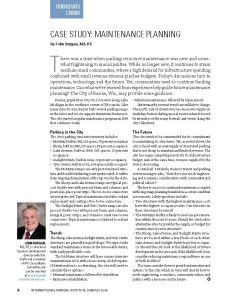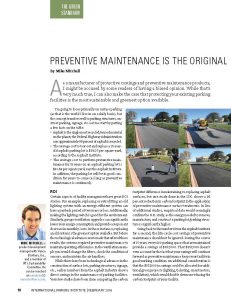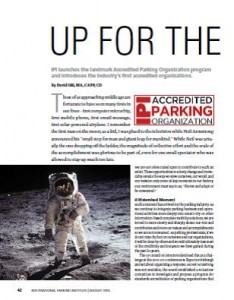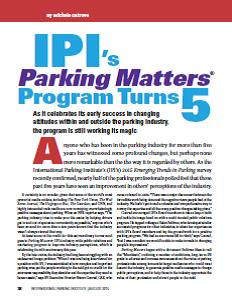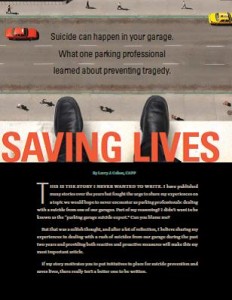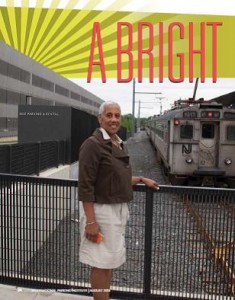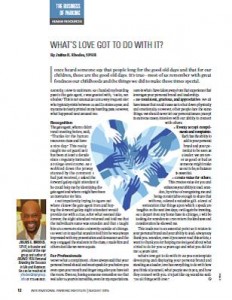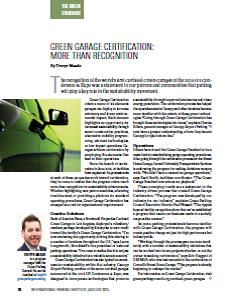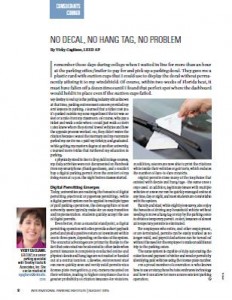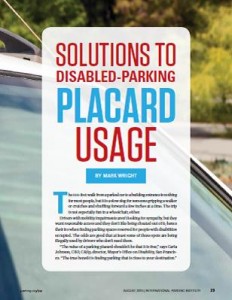 By Mark Wright
By Mark Wright
The 100-foot walk from a parked car to a building entrance is nothing for most people, but it is a slow slog for someone gripping a walker or crutches and shuffling forward a few inches at a time. The trip is not especially fun in a wheelchair, either.
Drivers with mobility impairments aren’t looking for sympathy, but they want reasonable access and they don’t like being cheated out of it; hence their ire when finding parking spaces reserved for people with disabilities occupied. The odds are good that at least some of those spots are being illegally used by drivers who don’t need them.
“The value of a parking placard shouldn’t be that it is free,” says Carla Johnson, CBO, CASp, director, Mayor’s Office on Disability, San Francisco. “The true benefit is finding parking that is close to your destination.”
Besides upsetting those being cheated, such behavior by the able-bodied offends cultural norms about fairness. The typical human response to a suspected cheater—at least in most democratic societies—is a quick, heartfelt rebuke: “Hey, that’s not right. You can’t do that!”
In the U.S., parking placard abuse also subverts the intent and spirit of the Americans with Disabilities Act (ADA), which was passed 25 years ago to help ensure that people with disabilities can access the same public spaces and services as everyone else. Indeed, nations around the globe have laws aimed at protecting disabled individuals in a variety of ways.
And while feeling cheated is bad enough, a driver with ambulatory limitations can feel downright violated when he or she is targeted by placard thieves. In Baltimore, Md., for example, 20 to 25 percent of disabled-parking placards were being stolen every month on average prior to recent reforms, fueling a burgeoning black market for them, according to Peter Little, executive director of the Baltimore City Parking Authority.
Moreover, how we define and communicate about placard problems requires clarity and sensitivity, notes Ken Husting, PE, senior transportation engineer in the Parking Meters Division at the Los Angeles Department of Transportation. “There’s a distinction between misuse and abuse,” he says. “It’s a question of having the legal right to park in a spot versus ‘should’ they park in that spot.”
Laws themselves can further complicate the challenge, adds Johnson, who has been a member of the disability community since 1992 and has worked with disability rights laws since 1993; she joined the San Francisco Mayor’s Office in 2008.
“The current laws for disability placards have the right intention but the wrong outcome; they actually make it harder for people with disabilities to find accessible parking when and where they need it,” Johnson says.
Placard-usage difficulties—and solutions being explored and implemented—vary from city to city and state to state. (To adapt the late Tip O’Neill’s famous saying about politics: All parking is local. Likewise, disabled-parking issues.)
The National Conference of State Legislatures reports that states have experimented with a variety of measures to deal with outright scofflaws. Recent examples include:
Photo ID placards (Massachusetts, New Mexico, and South Carolina).
More-detailed verification statements from physicians (Illinois, Massachusetts, Michigan, New Jersey, and Washington).
Placards with more prominent expiration dates (New Jersey and Washington).
Tougher penalties (Connecticut, Massachusetts, Michigan, and New Jersey).
Databases of disabled permit holders provided to police by motor vehicle departments.Disabilities-oriented community service for second-time offenders (Washington).
Raleigh: Everyone Pays
In North Carolina, City of Raleigh Parking Administrator Gordon Dash, CAPP, found that placard abuse and misuse was mainly a convenience issue in the city because handicapped parking on the streets was free. Many people who simply wanted to park close to work commonly used placards to snag disabled-designated spots, leaving their vehicles there all day.
“When I came in 2007 this was going on quite a bit,” says Dash. “There were no meters downtown at the time. When we put them in I started getting calls from merchants saying, ‘We have handicapped parkers parking here, so how are we going to solve that problem if they can sit there all day with impunity?’”
The solution: Charge for on-street disabled parking but allow disabled parkers to pay for as many hours as they needed. It was a strategy that took time, television news reporters chasing after placard abusers, a business community willing to drive the issue forward with the city council, and political finesse to achieve.
“State law here says handicapped parking shall be unlimited,” says Dash. “Pricing is not even mentioned.”
Dash says the change eliminated almost all the abuse, except for those employees working at the state capitol.
“We’ve had no problems since 2010,” Dash says. “We saw all the immediate results in the first couple of months. We had to go zone by zone installing new meters, which took about eight months, but by that time, all the downtown core problems were gone.”
L.A. and D.C.: Considering Options
In Los Angeles, a parking stakeholder working group identified California’s disabled-parking placard law as needing reform, which prompted the mayor’s office to have the city’s department of transportation and department on disability convene a staff working group to develop specific recommendations.
“We’re looking at a world of possibilities to see what makes the most sense,” says Ken Husting, PE, senior transportation engineer in the parking meters division at the Los Angeles Department of Transportation.
Husting says staff is “discussing alternatives to strengthen enforcement and penalties, incorporate technology, address issuance of the placards, and remove the incentive for the misuse of placards.” Draft recommendations could be out in about six months, he says, but the process is taking longer than initially thought.
“Unfortunately, the most meaningful changes that will likely come out of the working group will need to be adopted at the state level,” Husting explains. “The recommendations on policies we do control will probably go through the commission on disability, the city council, and the mayor.”
The L.A. effort is similar in scope to the disabled-parking review San Francisco has been going through, although San Francisco’s is much further along, Husting notes.
L.A.’s objective to remove incentives for unintended placard usage is shared by the District of Columbia. Soumya Dey, PE, director of research and technology transfer for the D.C. Department of Transportation, and his team have been hard at work for several years considering the pros and cons of various approaches to the placard usage puzzle.
“We look at it from an occupancy perspective in a few parts of the city,” says Dey. “How many placards are being used, what is the turnover rate? We are looking at those who have placards but are not turning over. We want to take away the incentive for abuse.”
Because their exploration process is ongoing, Dey and colleague Evian Patterson, citywide parking division manager, are not ready for details to be published. Parts of the mix will likely include looking at reserved spaces for people with disabilities, the amount of time that should be allowed beyond the posted time, meter heights, and fee-related changes.
“We’re working with the ADA community to see if programs are working or not and addressing the need for persons with disabilities at the curbside,” says Dey. “We have to listen and meet with the community, hear their concerns, address their concerns, and use this as a vehicle to improve the parking experience for all.”
“It’s a very sensitive issue for the millions of visitors who come here from around the world, as well as the commuters who come into the city from around the region,” adds Patterson. “The District is in a unique position in a legislative context. We rely on developing standards and rulemaking, with guidance and communication from the rest of the region.”
Patterson says they’ve been looking closely at the steps taken by nearby Arlington County, Va., and Baltimore.
Baltimore: Big Results
The rampant theft and illicit sale of placards noted earlier was just one element of a parking system in Baltimore that left on-street disabled spaces in short supply. In an attempt to create 15 to 20 percent disabled-parking space availability on the street, the city raised rates to help shift long-term parkers into garages. The move backfired.
“It actually exacerbated the abuse of placards when we raised the rates,” says Peter Little, executive director of the city’s parking authority. “There was an explosion of abuse.”
To combat the problem, the city’s parking division got together with the mayor’s commission on disabilities and developed an ambitious plan called Project Space. Its goal: Create a space for everyone.
“We started meeting with the commission four years ago,” says Little. “Then phase one launched in mid-July of last year throughout a large area downtown.”
Census data revealed that 10 percent of city residents had some type of mobility-restricting disability and would thus be eligible for a placard, so Little’s team reserved about 10 percent of on-street metered spaces for people with disabilities. They installed signs and single-space meters from IPS Group that accept credit cards and coins.
“We did not have any ordinances or laws dictating that people with disabilities should get free parking,” explains Little. “But the old crank-style meters were not ADA compliant. A state law says that if a person with a disability parks at a meter they should be able to park for double the duration of the meter, or up to four hours. So we set that for the new meters and the regular meters.”
Months prior to implementing the meter changes, the division launched a major public information campaign, led by Tiffany James, Baltimore City Parking Authority communications manager, with design and implementation support from a public relations firm. (The campaign was named one of four Best of 2015 winners of IPI’s Parking Matters® Marketing & Communications Awards.) They also briefed city and state politicians months in advance.
Prior to Project Space, says Little, 96 percent of metered spaces on select (central business district) blocks were occupied—and 72 percent of the people parked at those meters displayed a placard and stayed in those spaces for a very long time. “Now, those spaces are 77 percent occupied with availability of 23 percent—a dramatic increase.”
“We are at about 46 percent utilization of reserved metered disabled spaces, and we’d like to see that number go up as the word gets out,” says Little. “We’ve heard from people with disabilities that they are ecstatic about the on-street reserved spaces.”
He adds that Project Space has paid for itself during its first 10 months, recouping the approximately $600,000 the city invested in the initiative.
And the stolen placards? Little says theft has dropped to fewer than three per month.
Portland: Success
Calls for disabled-parking permit reform in Portland, Ore., were commonplace less than two years ago, as levels of placard use—particularly downtown—were conspicuously high.
“Free parking was not working for the disabled or for downtown businesses,” says Portland Bureau of Transportation Public Information Officer Diane Dulken. She says about one in nine vehicles parked downtown displayed a placard and tended to sit in the same space all day. That undermined the city’s goal of a healthy downtown that provided access for all.
After considerable study and citizen engagement, the city council passed a resolution in December 2013 to make a number of changes—including pay-to-park—to its disabled parking downtown and in three other areas. Those took effect July 1, 2014. Dulken says the city did ample outreach and issued warnings before starting enforcement.
As the city explained on its website: “The new program extends parking meter times for people holding Disabled Parking Placards and adds 105 reserved parking spaces for people holding these placards, including 32 specifically for wheelchair placard holders.”
Dulken says the changes improved access and freed up spaces. In fact, she says, some
of those 105 reserved spaces often go unused.
More Examples
Big cities are not the only ones to tackle disabled-parking usage issues. Hagerstown, Md., founded in 1762 and now home to about 40,000 people, requires payment at all of its meters, including those used by placard holders.
Parking professionals who responded to IPI’s recent Emerging Trends in Parking Survey said by a wide margin (62 percent) that free placards for disabled drivers should become a thing of the past. Nearly half (49 percent) said the parking industry should work more closely with state departments of motor vehicles and other agencies to make placards more difficult to obtain and use fraudulently.
Donald Shoup, PhD, recently retired from University of California, Los Angeles, has written about other jurisdictions opting to charge for disabled parking, including Arlington County, Va. He has also cited Michigan and Illinois as variations on charging all disabled-parking placard holders. Those states adopted a two-tier system based on the disabled person’s level of mobility impairment. Those with severe limitations park free, while the rest pay.
Have you addressed disabled parking abuse? Found success or encountered challenges with permits? IPI is working on this issue and wants to hear what you’ve done and your concerns, thoughts, and ideas. Please email Helen Sullivan at sullivan@parking.org and use ADA Abuse as the subject line.
Mark Wright is a freelance writer. He can be reached at mark@wrightscontent.com.
TPP-2015-08-Solutions To Disabled Parking Placard Usage

